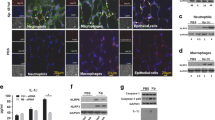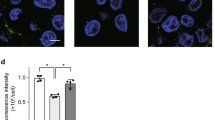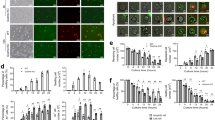Abstract
Neutrophil elastase (NE) is a potent serine proteinase1,2 whose expression is limited to a narrow window during myeloid development. In neutrophils, NE is stored in azurophil granules along with other serine proteinases3,4 (cathepsin C, proteinase 3 and azurocidin) at concentrations exceeding 5 mM (ref. 5). As a result of its capacity to efficiently degrade extracellular matrix, NE has been implicated in a variety of destructive diseases6. Indeed, while much interest has focused on the pathologic effects of this enzyme, little is known regarding its normal physiologic function(s). Because previous in vitro data have shown that NE exhibits antibacterial activity7–9, we investigated the role of NE in host defense against bacteria. Generating strains of mice deficient in NE (NE−/−) by targeted mutagenesis, we show that NE−/− mice are more susceptible than their normal littermates to sepsis and death following intraperitoneal infection with Cram negative (Klebsiella pneumoniae and Escherichia coli) but not Cram positive (Staphylococcus aureus) bacteria. Our data indicate that neutrophils migrate normally to sites of infection in the absence of NE, but that NE is required for maximal intracellular killing of Cram negative bacteria by neutrophils.
This is a preview of subscription content, access via your institution
Access options
Subscribe to this journal
Receive 12 print issues and online access
$209.00 per year
only $17.42 per issue
Buy this article
- Purchase on SpringerLink
- Instant access to full article PDF
Prices may be subject to local taxes which are calculated during checkout
Similar content being viewed by others
References
Bieth, J.C. Elastases: catalytic and biological properties. In: Regulation of Matrix Accumulation, Mecham, R., Ed. (Academic Press, New York), pp. 217–320 (1986).
Sinha, S. et al. Primary structure of human neutrophil elastase. Proc. Natl. Acad. Sci. USA. 84, 2228–2232 (1987).
Zimmer, M. et al. Three human elastase-like genes coordinately expressed in the myelomonocyte lineage are organized as a single genetic locus on 19pter. Proc. Natl. Acad. Sci. USA. 89, 8215–8219 (1992).
Takahashi, H., Nukiwa, T., Basset, P. & Crystal, R.C. Myelomonocytic cell lineage expression of the neutrophil elastase gene. J. Biol. Chem. 263, 2543–2547 (1988).
Liou, T.C. & Campbell, E.J. Nonisotropic enzyme—inhibitor interactions: a novel nonoxidative mechanism for quantum proteolysis by human neutrophils. Biochemistry 34 (49)16171–16177 (1995).
Snider, G.L. Emphysema: the first two centuries—and beyond. A historical overview, with suggestions for future research: Part 2. Am. Rev. Respir. Dis. 146, 1334–1615 (1992).
Odeberg, H. & Olsson, I. Mechanisms for microbicidal activity of cationic proteins of human granulocytes. Infect. Immun. 14, 269–1275 (1976).
Thorne, K.J.I., Oliver, C.R. & Barrett, A.J. Lysis and killing of bacteria bylysosomal proteinases. Infect. Immun. 14, 555–563 (1976).
Blondin, J., Janoff, A. & Powers, J.C. Digestion of E. coli proteins by human neutrophil elastase and chymotrypsin-like enzyme (Cathepsin G): experiments with a cell free system and living leukocytes. In: Neutral Proteases of Human Polymorphonuclear leukocytes, J. Havemann and A. Janoff Ed. (Baltimore/Munich: Urban & Schwartzenberg), pp. 39–55 (1978).
Kabha, K. et al. Relationships among capsular structure, phagocytosis, and mouse virulence in Kebsiella pneumoniae . Infect. Immun. 63, 848–852 (1995).
Baorto, D.M. et al. Survival of FimH-expressing enterobacteria in macrophages relies on glycolipid traffic. Nature 389, 636–639 (1997).
Belaaouaj, A., Walsh, B.C., Jenkins, N.A., Copeland, N.C. & Shapiro, S.D. Characterization of the mouse neutrophil elastase gene and localization to chromosome 10. Mammalian Cenome 8, 5–8 (1997).
Senior, R.M. et al. Human 92- and 72-kilodalton type IV collagenases are elastases. J. Biol. Chem. 266, 7870–7875 (1991).
Bradley, P.P., Priebat, D.A., Christensen, R.D. & Rothstein, C.J. Measurement of cutaneous inflammation: estimation of neutrophil content with an enzyme marker. Invest. Dermatol. 78, 206–209 (1982).
Malaviya, R. et al. Mast cell phagocytosis of FimH-expressing enterobacteria. J. Immun. 152, 1907–1914 (1994).
Miyasaki, K., Bodeau, A.L. & Flemming, T.F. Differential killing of Actinobacillus actinomycetemcomitans and Capnocytophaga spp. by human neutrophil granules. Infect. Immun. 59, 3760–3767 (1991).
Wewers, M.D., Herzyk, D.J. & Gadek, J.E. Alveolar fluid neutrophil elastase activity in the adult respiratory distress syndrome is complexed to alpha-2-macroglobulin. J. Clin. Invest. 82, 1260–1267 (1988).
Author information
Authors and Affiliations
Rights and permissions
About this article
Cite this article
Belaaouaj, A., McCarthy, R., Baumann, M. et al. Mice lacking neutrophil elastase reveal impaired host defense against gram negative bacterial sepsis. Nat Med 4, 615–618 (1998). https://doi.org/10.1038/nm0598-615
Received:
Accepted:
Issue Date:
DOI: https://doi.org/10.1038/nm0598-615



